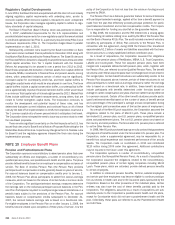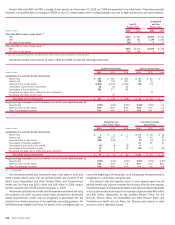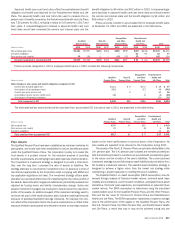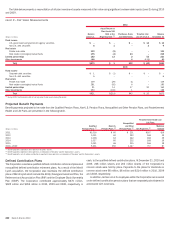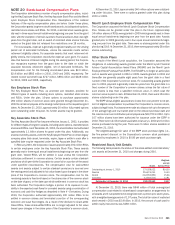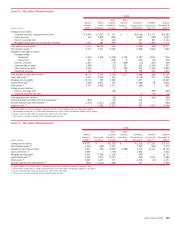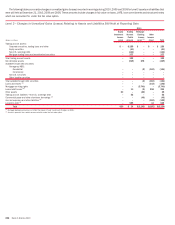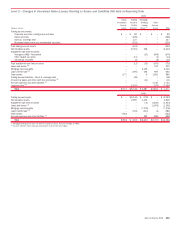Bank of America 2010 Annual Report Download - page 226
Download and view the complete annual report
Please find page 226 of the 2010 Bank of America annual report below. You can navigate through the pages in the report by either clicking on the pages listed below, or by using the keyword search tool below to find specific information within the annual report.
During 2010 and 2009, the Corporation recognized in income tax expense
$99 million and $184 million of interest and penalties, net-of-tax. At both
December 31, 2010 and 2009, the Corporation’s accrual for interest and
penalties that related to income taxes, net of taxes and remittances, was
$1.1 billion.
Significant components of the Corporation’s net deferred tax assets and
liabilities at December 31, 2010 and 2009 are presented in the table below.
(Dollars in millions)
2010 2009
December 31
Deferred tax assets
Net operating loss carryforwards (NOL)
$18,732
$17,236
Allowance for credit losses
14,659
13,011
Credit carryforwards
4,183
2,263
Employee compensation and retirement benefits
3,868
4,021
Accrued expenses
3,550
2,134
Stateincometaxes
1,791
1,636
Capital loss carryforwards
1,530
3,187
Security and loan valuations
427
4,590
Other
1,960
2,308
Gross deferred tax assets
50,700
50,386
Valuation allowance
(2,976)
(4,315)
Total deferred tax assets, net of valuation allowance
47,724
46,071
Deferred tax liabilities
Available-for-sale securities
4,330
878
Mortgage servicing rights
4,280
5,663
Long-term borrowings
3,328
3,320
Equipment lease financing
2,957
2,411
Intangibles
2,146
2,497
Fee income
1,235
1,382
Other
2,375
2,641
Gross deferred liabilities
20,651
18,792
Net deferred tax assets
$27,073
$27,279
On January 1, 2010, the Corporation adopted new consolidation guidance
and the transition adjustment included an increase of $3.5 billion in retained
earnings which was offset against net deferred tax assets. On July 1, 2010,
the Corporation adopted new accounting guidance on embedded credit de-
rivatives and the related fair value option election and the transition adjust-
ment included an increase of $128 million in retained earnings which is offset
against net deferred tax assets.
The U.S. federal deferred tax asset excludes $56 million related to certain
employee stock plan deductions that will be recognized and will increase
additional paid-in capital when realized.
The table below summarizes the deferred tax assets and related valuation
allowances recognized for the net operating and capital loss carryforwards
and tax credit carryforwards at December 31, 2010.
(Dollars in millions)
Deferred
Tax Asset
Valuation
Allowance
Net
Deferred
Tax Asset
First Year
Expiring
Net operating losses – U.S. $9,037 $ – $9,037 After 2027
Net operating losses – U.K. 9,432 – 9,432 None
(1)
Net operating losses – other non-U.S. 263 (36) 227 Various
Net operating losses – U.S. states
(2)
2,221 (847) 1,374 Various
Capital losses 1,530 (1,530) – After 2013
General business credits 2,442 – 2,442 After 2027
Alternative minimum and other tax
credits 214 – 214 None
Foreign tax credits 1,527 (306) 1,221 After 2017
(1)
The U.K. NOL may be carried forward indefinitely. Due to change-in-control limitations in the three years prior to
and following the change in ownership, this unlimited carryforward period may be jeopardized by certain major
changes in the nature or conduct of the U.K. businesses.
(2)
The NOL and related valuation allowance for U.S. states before considering the benefit of federal deductions
were $3.4 billion and $1.3 billion.
The Corporation concluded that no valuation allowance is necessary to
reduce the U.K. NOL, U.S. NOL and general business credit carryforwards
since estimated future taxable income will be sufficient to utilize these assets
prior to their expiration. With the acquisition of Merrill Lynch on January 1,
2009, the Corporation established a valuation allowance to reduce certain
other deferred tax assets to the amount more-likely-than-not to be realized
before their expiration. During 2010 and 2009, the Corporation released
$1.7 billion and $650 million of the valuation allowance attributable to Merrill
Lynch’s capital loss carryforward due to utilization against net capital gains
realized in 2010 and 2009. The valuation allowance also increased due
primarily to increases in operating loss carryforwards generated in certain
state jurisdictions for which management believes it is more-likely-than-not
that realization of these assets will not occur.
At December 31, 2010 and 2009, U.S. federal income taxes had not been
provided on $17.9 billion and $16.7 billion of undistributed earnings of
non-U.S. subsidiaries earned prior to 1987 and after 1997 that have been
reinvested for an indefinite period of time. If the earnings were distributed, an
additional $2.6 billion and $2.5 billion of tax expense, net of credits for
non-U.S. taxes paid on such earnings and for the related non-U.S. withholding
taxes, would have resulted as of December 31, 2010 and 2009.
NOTE 22 Fair Value Measurements
Under applicable accounting guidance, fair value is defined as the exchange
price that would be received for an asset or paid to transfer a liability (an exit
price) in the principal or most advantageous market for the asset or liability in
an orderly transaction between market participants on the measurement
date. The Corporation determines the fair values of its financial instruments
based on the fair value hierarchy established under applicable accounting
guidance which requires an entity to maximize the use of observable inputs
and minimize the use of unobservable inputs when measuring fair value.
There are three levels of inputs that may be used to measure fair value. For
more information regarding the fair value hierarchy and how the Corporation
measures fair value, see Note 1 – Summary of Significant Accounting Prin-
ciples. The Corporation accounts for certain corporate loans and loan com-
mitments, LHFS, structured reverse repurchase agreements, long-term de-
posits and long-term debt under the fair value option. For more informations,
see Note 23 – Fair Value Option.
Level 1, 2 and 3 Valuation Techniques
Financial instruments are considered Level 1 when the valuation is based on
quoted prices in active markets for identical assets or liabilities. Level 2
financial instruments are valued using quoted prices for similar assets or
liabilities, quoted prices in markets that are not active, or models using inputs
that are observable or can be corroborated by observable market data for
substantially the full term of the assets or liabilities. Financial instruments are
considered Level 3 when their values are determined using pricing models,
discounted cash flow methodologies or similar techniques, and at least one
significant model assumption or input is unobservable and when determina-
tion of the fair value requires significant management judgment or estimation.
The Corporation uses market indices for direct inputs to certain models
where the cash settlement is directly linked to appreciation or depreciation of
that particular index (primarily in the context of structured credit products). In
those cases, no material adjustments are made to the index-based values. In
other cases, the use of market indices is inherently limited because the fair
value of an individual position being valued may not move in tandem with
changes in fair value of a specific market index. Accordingly, market indices
are used as inputs to the valuation, but are adjusted for trade specific factors
such as rating, credit quality, vintage and other factors.
224 Bank of America 2010


